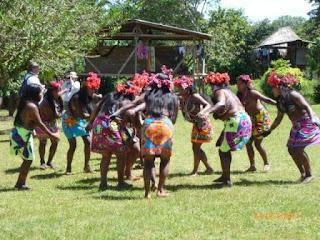Today is another highlight of the cruise - a visit to see the Embera Indians who live in the Darien rainforest region of Panama. Ever since I first read about the Darien Gap, the stretch of land on the borders of Colombia and Panama, I have been fascinated by this region. The Darien Gap refers to the fact that there is no road linking the two continents of North and South America. Very few successful attempts have been made to 'drive' through the Gap, but, in reality, it is not possible because of the swamps and rivers barring the way.
We were moored about three miles off the coast of the Darien National Park and at 9am we started to load the Zodiacs for the hour and a half ride to the Embera village.
As there were more passengers going to the village than the Zodiacs could take, Silversea had laid on additional boats from the village. As it turned out, we were amongst the lucky ones who went in an Indian dugout canoe.
The dugout canoes waiting to take us to the Embera village in the rainforest.
Eight of us boarded the canoe, which was powered by a 40hp outboard motor. The canoe had two Embera villagers, one who drove the boat and the other who sat on the bow and guided the canoe around the many logs floating in the water. The Embera paint themselves with geometric patterns. Our driver looked pretty fearsome with his painted face!
It took us about half an hour to reach the shore and then we headed up the Mogue river through the mangrove swamps.
We saw several species of birds as we motored up the river - pelicans, ibis, boobies, a curlew, several small swift-like birds and some colourful ones we could not name. Further on, we saw a kingfisher and then a most impressive flamingo-type bird in flight. We later learned it was probably a roseate spoonbill.
At times, we had to dodge fallen trees and go very slowly, as the river was shallow because of the low tide. After about an hour, we came to the village where we were greeted by lines of children dressed in traditional clothes.
A group of men banged drums, accompanied by a solitary pipe player.
We then walked along a path to the centre of the village. Three girls, who we learned were aged six, nine and twelve, took hold of our hands and walked with us.
When we reached the village, we came to the first of many Embera houses. The houses are raised up on stilts to keep them cool, as well as to prevent animals from reaching the living space, which is open on all sides. I wondered how good the houses are at keeping out the rain.
We reached the communal house where a shaman was performing a ritual to heal a young woman. Apparently, the villagers use western medicine first but then, if they do not get better, they go to the shaman.
The impressive interior of the roof that covered the communal house. I couldn't see anything other than vines and grasses holding the whole thing together!
Then, Moondog introduced us to the Chief and his deputy. The Chief greeted us all and was asked several questions, including how he was elected. Apparently, the members of the tribe line up behind the candidates and the one with the longest line wins the election.
After the welcome by the Chief, there were tribal dances performed by Indian girls.
The village has about 470 people and, within the last twenty years, the Embera Indians have gained independence and now run their own autonomous region within Panama.
After the dances, we had an opportunity to buy some of the very intricate weaving and carving that the tribe does to supplement their income. We bought two small baskets and a plate, all with very colourful patterns. I also bought a small carved Cayman crocodile.
We left the village after an hour or so and, as we walked back to where the dugouts were moored, we went past the village school, where this group of smiling girls and boys were lined up at the open window.
We returned to our dugout, where we were joined by the young brother of one of our two crewmen. The boy sat at the bow and looked at us all with a stern face and never once smiled.
In contrast to the journey upriver to the village, we were able to speed back to Silver Explorer, as the tide had come in and the river had risen.
One of the large trees that grow in the swamps with its tangled mass of exposed roots. Many of the trees have a buttress base to the trunk, which gives the trees added stability in the swampy ground conditions.
Magnificent trees lined the river.
One of the Zodiacs speeding past us, on the way back down the river.
A beautiful cloud formation as we headed back out to sea and Silver Explorer.
It has been a very interesting and enjoyable day and one I will remember. Tonight we set sail for Isla de Coiba and our last day in Panama. The island is about 240 miles away and we will arrive there after lunch tomorrow.





























No comments:
Post a Comment